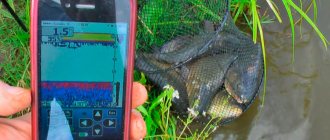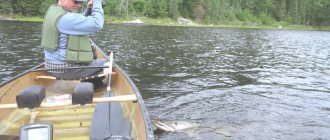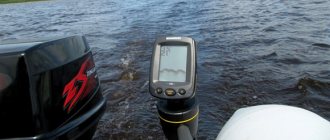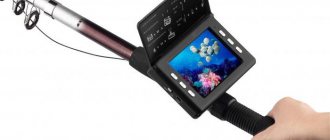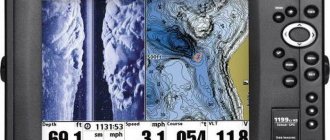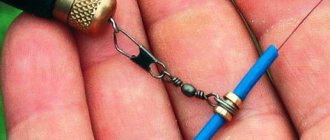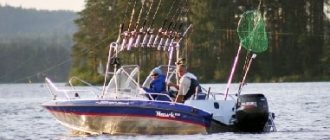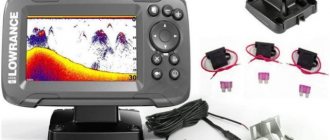Providing the echo sounder with uninterrupted power supply from the PLM generator coil
Our video blog has two boat sets at its disposal, and accordingly, two motors:
1. Mercury 15
2. Yamaha 8
Almost every engine can get voltage, and the first thing we did was install a generator coil with a rectifier on a Mercury 15 motor in order to provide our echo sounder with constant and uninterrupted power. From the factory, the Mercury 15 PLM is not equipped with a generator coil, so we needed to order one. For those who also need it, I leave the following information:
To order an original alternator coil for a Mercury 15 motor, enter the following Purtnumber in the search bar of your browser - “42282A 4” and the search engine will offer you several purchasing options.
The generator coil, depending on the engine speed, produces an alternating voltage, so together with it it is necessary to install a voltage regulator or rectifier that would allow receiving constant and stable 14V necessary to charge the battery. This was the reason that we turned to Andrey Sphinx, who is notorious on our website, who makes such rectifiers with his own hands.
You can watch the installation process of the coil and rectifier in the video at the link >>>
Also, we equipped the Yamaha with a rectifier, which, unlike Merck, is already equipped from the factory with both a generator coil and a voltage regulator, but using a stock rectifier to power expensive devices, as we found out, is absolutely not worth it. In simple words, the Yamaha regulator is made on a simpler circuit, intended only for charging the battery. Andrey’s rectifier, in turn, is more complex and is capable of powering not only the battery, but also the device itself directly. Therefore, without further hesitation, we installed a rectifier from Sphinx on the Yamaha.
Video here >>>
So we closed the issue of powering the Helix and moved on to installing the echo sounder and sensor in the boat.
I’ll add to this block that at the moment and until today, we have never directly powered the echo sounder. We use a 12 Ah battery, which powers the echo sounder, and itself is powered by the motor. The scheme is working, but does not imply constant, uninterrupted operation of the echo sounder - having stood at the point, we turn off the device. Also, the battery tends to discharge during long searches for fish at very low speeds, especially on a Yamaha 8 engine.
Andrey's announcement about the sale of stabilizers at the link >>>
How to use a fish finder
The Humminbird PiranhaMAX 160 fish finder is activated by pressing the POWER button. The system boots very quickly. When the device is fully turned on, you can immerse the sensor in water.
From this moment you can begin to explore the water area. You need to select the operating mode of the hydroecholocation system. This can be done either in automatic mode or in individual configuration mode. To work in individual settings mode, you cannot do without experience in fishing. The menu also allows you to select the scale of information display, sound alert volume, and display or hide additional data.
After completing work with the hydroecholocation system, you need to turn off the power to the device. This is useful both for safety of use and for saving energy consumption.
Installing a large-screen structurer and a side-scanning echo sounder sensor on a PVC boat
Having compared all the pros and cons, we decided to mount the echo sounder screen on the lyctros. After a little monitoring of Novosibirsk manufacturers of various UKBs, I caught my eye, whose fastening elements we had already used before. But, not surprisingly, the manufacturer did not have any special mounting blocks for such screens. But Dmitry, the production manager, willingly agreed to try to invent something specifically for Helix 12, for which many thanks to him!
This is what the mounting block looked like when received
Both of our boats are equipped with additional light cables for attaching various things to it. After the first operation, it became clear that it would not be superfluous to make additional grooves on the mounting block in order to attach the echo sounder to both cables, thereby firmly fixing it to the cylinder. Also, it was decided to shorten the bottom shelf intended for the battery and use it as a “table” for baits. It was decided to hide the battery in a bag that is attached to the can. Dmitry “finished” the design bureau according to our requests, and now, when there is a strong wave, we attach the echo sounder to two lines.
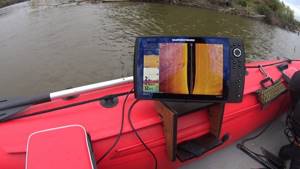
Not the best photo, but still, on it you can see the additional groove that has appeared below for the lower lycrop and the shortened lower shelf. Let me repeat that we use the two-line setup only in strong waves.
This may not be the most ideal solution for mounting such a screen, but by and large, it is a working solution. In principle, you can use it.
Manufacturer's website >>>
While I’m writing this article, I understand how great it is that in Novosibirsk there are so many fishing masters whom the site has brought together under one roof. And this is what I mean - on the pages of our forum, we again found the person we needed, who himself makes clamps for echo sounder sensors, and specifically, he can make a clamp for a side-scanning sensor, which we also needed. The design feature of mounting such a sensor is as follows:
Due to the fact that the sensor scans not only downwards, but also in both directions (the sensor beam has an angle of 180 degrees), its mounting on a clamp, used for echo sounder sensors without side scanning, is not a suitable option. It’s not difficult to guess why - on the one hand, the motor leg will obstruct the view. For this reason, the sensor must go under the boat. Yes, some clamps that are not designed for side-scan sensors can be reversed, thereby turning the sensor in the opposite direction. But in this case, the left side on the echo sounder screen will be right, and the right side, respectively, left. Agree, not a very convenient solution. The sensor must be mounted in the correct position. So, another Dmitry, a clamp master, made us this fastening element in the required form, for which we are also very grateful to him. In addition, Dmitry is a brewer and treated us to a bottle of his own beer, which we gladly tried before the festival “Obskaya Zaruba 2017” - it probably gave us strength and good spirits, because the event was successful and our strength lasted until the very end , but let's return to our sheep.
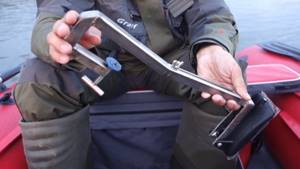
Dmitry's announcement about the sale of clamps at the link >>>
So, the echo sounder is securely mounted in the boat, the echo sounder sensor scans in both directions without problems, the battery constantly maintains a charge - everything is ready for use. Well, what are you, Helix?
Preface
Friends, the first thing I want to say is this. If you think that it’s enough just to install a structurer in a boat and immediately go punish large fish, then know that this is not so, and not even close to that. To begin with, the device requires you to understand it. Doing this is somewhat more difficult than with simpler devices to which we are all accustomed. Here are the very first requirements we encountered:
1. Understand the side scan display as such.
2. Learn to correctly understand detailed echo sounder displays on the side scanner, such as fish silhouettes (which can be used for useful selection), correctly recognize relief features, navigate and correctly determine the location of interesting screen displays.
3. Learn to most effectively use the capabilities of the echo sounder and its scanning modes in order to find promising places even faster.
4. Learn to quickly and correctly position yourself at already given points, which is very, very difficult when using a simple anchor. (By the way, it was only with the structural engineer that I realized how incorrectly I could have positioned the point before. The most banal thing is distance control. Sometimes it gets ridiculous when, when setting up in a current or strong wind, it seems to you that you have stood up, give or take , as expected, but in fact “flew away" from the desired point 50-70 meters further. Distance control is one of the most important details when setting, which is especially important when fishing in the current, in the wind and with a simple anchor.)
5. Learn to combine several modes, understanding how to use each of them: cartography, navigation, scanning modes - make the most of them by maneuvering these modes correctly, using the right mode at the right time. After all, if there is no complete understanding of what is needed, why and when, then you can waste a lot of time for a long time and the echo sounder will turn from an assistant into an enemy, eating up time without return.
6. And, in my opinion, one of the most important points is not to go completely headlong into the echo sounder, and leave yourself to navigate the reservoir with the help of your eyes. I have had the experience of fishing with anglers who, having boarded the boat, immediately go into the structure without raising their heads, and I am convinced that this is also fundamentally wrong and directly affects the worst result. The very first search in an unfamiliar place should be done with your eyes and only then with an echo sounder - this will significantly reduce the time and leave you the opportunity to make more casts of bait to the right place.
Side scanning and fish silhouette display
Of course, the very first advantage of the Humminbird Helix 12 and, in general, structural engineers is side visibility. First, I want to explain the side scanner display. This picture from Humminbird explains it best.
The Helix 12 side scan image looks slightly different, but the essence of all SI displays is the same: the “road” in the middle is water, the structures on the sides are the bottom, on the right and left, respectively. The relief displayed on the screen is depicted as accurately as possible on the 3D diagram nearby. In principle, an echo sounder allows you to see the bottom, precisely, with the accuracy of this 3D image.
As they say, in one of their videos, the Shcherbakov brothers, whom I respect, the principle of work of a structural engineer is very similar to the situation when you are driving along an asphalt road through a field: look to the right - a stream is flowing, several trees along its bank, look to the left - hollows, overgrown holes Birds are sitting on the grass, on a hillock, in the shade of a bush. And indeed, something like this, and with a side view of the echo sounder.
This is what the Helix 12 picture looks like
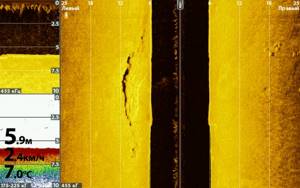
In this case, there are three displays on the screen: SI, DI and Sonar. The screen size proportions are what we considered optimal. Side scanning mode as the main one, downward scanning and sonar mode as additional ones. If we look at the SI picture, we can see the following:
the line in the middle cutting the screen in half is the movement of our craft. The dark road is a layer of water. Now imagine that the bottom, which is yellow, lies in a different plane. It’s as if a sheet of A4 format was bent in half, creating an angle of 90 degrees, where one plane shows us the thickness of the water, and the other the bottom. At the same time, we look at the bottom from top to bottom. The beam of the side scanning sensor is set to 25 meters, as evidenced by the dividing scale on top of the screen - 6, 12, 18 and 25 meters. The side scan sensor is set to a frequency of 455 kg, which we consider optimal. The scanning frequency is displayed in the lower left corner of the screen for each of the three scanning modes. In the lower left corner of the general screen the depth (5.9 m), speed (2.4 km/h) and water temperature (7.0 C) are displayed.
On the left side, between marks of 6 and 12 meters, we see bottom anomalies; on the right side, beyond the mark of 18 meters, we see some accumulation of longitudinal silhouettes - two of them are “thinner” and more slender, the other three are wider. Not always, but in most cases, I define such silhouettes as silhouettes of predators (pike perch, pike) and in this particular case, not the smallest ones. Considering that the picture is from the Ob Reservoir, from the place where schools of pike perch are walking for this period of time, I assume that the silhouettes belong to this particular fish.
An incomprehensible display on the left side, just below the zero mark, throughout the entire stroke of the craft is turbulence from the operation of the motor.
Model overview
The Humminbird 160 sonar system allows you to obtain information about the state of the water column over a large study area. The Humminbird Piranhamax 160 system (sensor plus digital analysis unit) is well suited for amateur use.
The Humminbird Piranhamax 160 echo sounder has a low price, but the level of information content is high. The accuracy of data on the state of the bottom, its topography, the structure of the water area, objects, snags, algae and most importantly - the presence of fish - is confirmed by the results of numerous independent examinations and reviews of the Humminbird Piranhamax 160.

